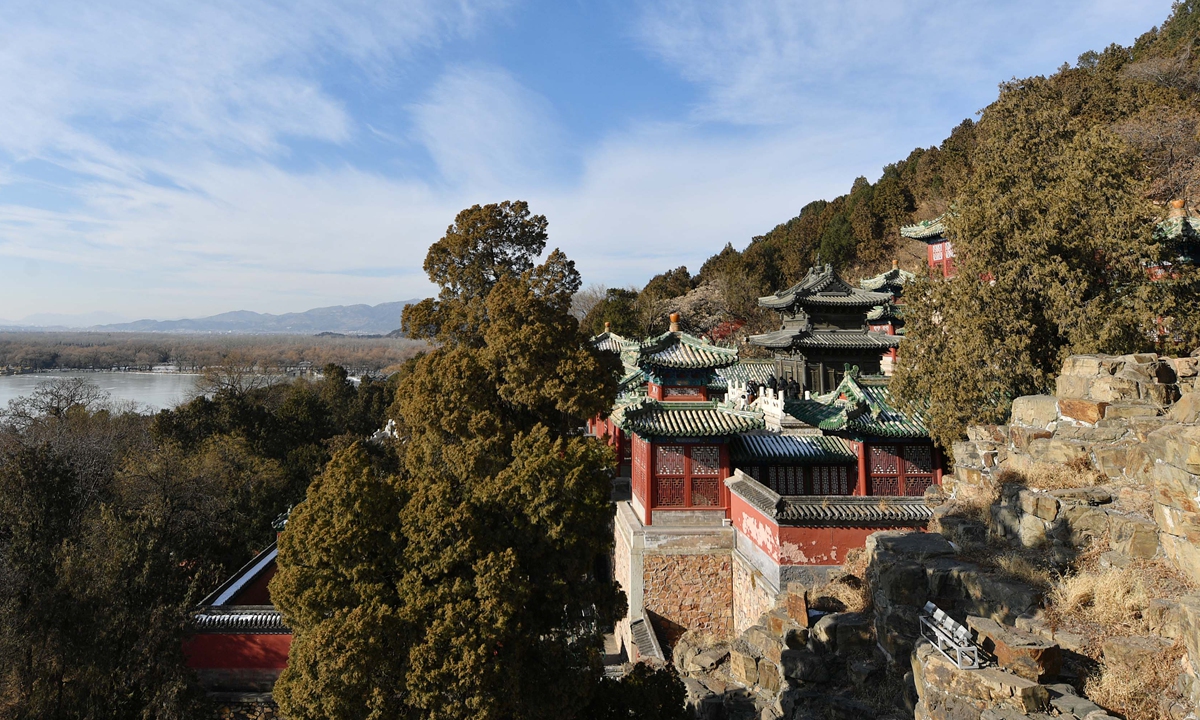
The bronze latticed panel, part of a window of the Baoyun Pavilion in the Summer Palace Photo: VCG
One of China's most exquisite pieces of all-bronze architecture recently witnessed the return of its long-lost precious component. On Thursday, the bronze window panel on the Baoyun Pavilion of the Summer Palace in Beijing was donated by three benefactors after an auction in France, part of an evolving trend in repatriating cultural artifacts on the international stage.
As one of the well-known royal gardens from the Qing Dynasty (1644-1901), the Summer Palace boasts an abundance of treasures rivaling the renowned Yuanmingyuan, or the Old Summer Palace. The Baoyun Pavilion, perched on the hills of the Summer Palace, was constructed in the 20th year of the Qianlong Emperor's reign (1755). Its unique appearance, crafted entirely from bronze, and featuring a simulated wooden structure, sets it apart from its surroundings, giving it a distinctive presence.
The bronze window panel had previously gone unsold at two separate auctions, only to be finally noticed and acquired by Li Lei, a main contributor to the donation, in a third attempt. Despite twists and turns, Li told the Global Times on Monday that he believes that the entire process, from auction to repatriation, serves as a window for the world to better understand Chinese cultural heritage and traditions.
"Many people view auctions as simple transactions or simply another sad story behind a lost treasure. But I see the opposite," he said. "Overseas, cultural artifact auctions provide the international community with another dimension to comprehend a culture. For example, when a Chinese relic fetches a high price in an auction, it captures societal attention, prompting many who were initially unaware to actively learn and explore the value of the artifact."

The Baoyun Pavilion in the Summer Palace Photo: VCG
A long way back
Amid the ostentatious structures and winding corridors within the Summer Palace, the Baoyun Pavilion (lit gem cloud pavilion) has a slightly faded bronze exterior, yet its rare forging techniques and wood-like design make it truly stand out within the Summer Palace's landscape.
It was in June 2023, while wrapping up a business trip in France and preparing to return to China, Li stumbled upon the clues regarding the unique window artifact that belongs to the pavilion.
According to historical documents, there are only five all-bronze architectural structures across China, including Shandong, Shanxi, Yunnan and Beijing. Drawing on his 30 years of experience in artifact collection, Li recognized the potential origin of the window panel when he saw its photos in the auction catalog.
"The window panel, crafted 270 years ago, is exquisitely carved in a diamond pattern," noted Li as he vividly recounted his initial sighting. In his memory, only two structures could possess such intricately designed bronze window panels: Yunnan's Fengshan Mountain Bronze Hall and the Baoyun Pavilion in the Summer Palace.
Historical records indicate that the latter endured the invasion of the Anglo-French Alliance Forces in 1860 and the hardship during the Boxer Movement in 1900. Originally housing 12 doors, 20 windows and 70 window panels, the pavilion lost 10 windows and 31 window panels in the early 20th century, according to the Summer Palace.
After thorough research, Li confirmed that this artifact was indeed a component of the windows of the Baoyun Pavilion.
With the support of two fellow collectors - one Chinese friend and one French-born Chinese enthusiast - the trio successfully acquired the relic at the auction before reaching out to China's National Cultural Heritage Administration (NCHA).
According to Du Juan, deputy director of the Summer Palace, the recently returned bronze window panel "is identical in shape and structure to the existing ones in the Baoyun Pavilion and matches photographs taken by Scottish photographer John Thomson in 1871.
As a collector based in Beijing, Li told the Global Times that he was not at all confident when he decided to place a high bid on an item whose value and origin were judged mainly by his experience.
"I was not sure whether the object was valuable enough as a cultural relic or whether it belonged to the Summer Palace. Or whether its donation would go as I had thought.
"But when I proposed the idea of a donation, my friends agreed without hesitation. At that moment, I felt it was something I needed to do," Li said.
"When a person living abroad sees a cultural relic that once belonged to their homeland, the desire to bring it back home peaks immediately. Fortunately, I had the means to acquire it, and China's development gives me the confidence."
Unstoppable trend
As lost cultural heritage repatriation increasingly becomes an internationally recognized issue, China, as a major custodian of cultural artifacts, has played an active role in pushing this agenda forward in recent years.
China and the US have jointly announced the extension of the validity period for an intergovernmental memorandum of understanding (MOU) to prevent the illegal entry of Chinese cultural relics into the US, media reports said.
The MOU, established in 2009, has helped China recover 504 sets of Chinese cultural relics lost in the US since its signing. For China, similar intergovernmental agreements were signed with 26 countries, including Italy and India, as of December 2023.
According to statistics of NCHA in 2019, China has facilitated the return of more than 300 batches with more than 150,000 pieces of Chinese cultural relics that were lost overseas through either law enforcement cooperation or donations since 1949.
Baoyun Pavilion alone witnessed the return of precious objects from the US and France, respectively, in 1993 and 1995, followed by the donation this year.
"The return of cultural relics not only rectifies historical injustices but also promotes the inheritance and development of cultural heritage. We hope to contribute more to the promotion of Chinese culture when it comes to international cultural exchanges," said Li.